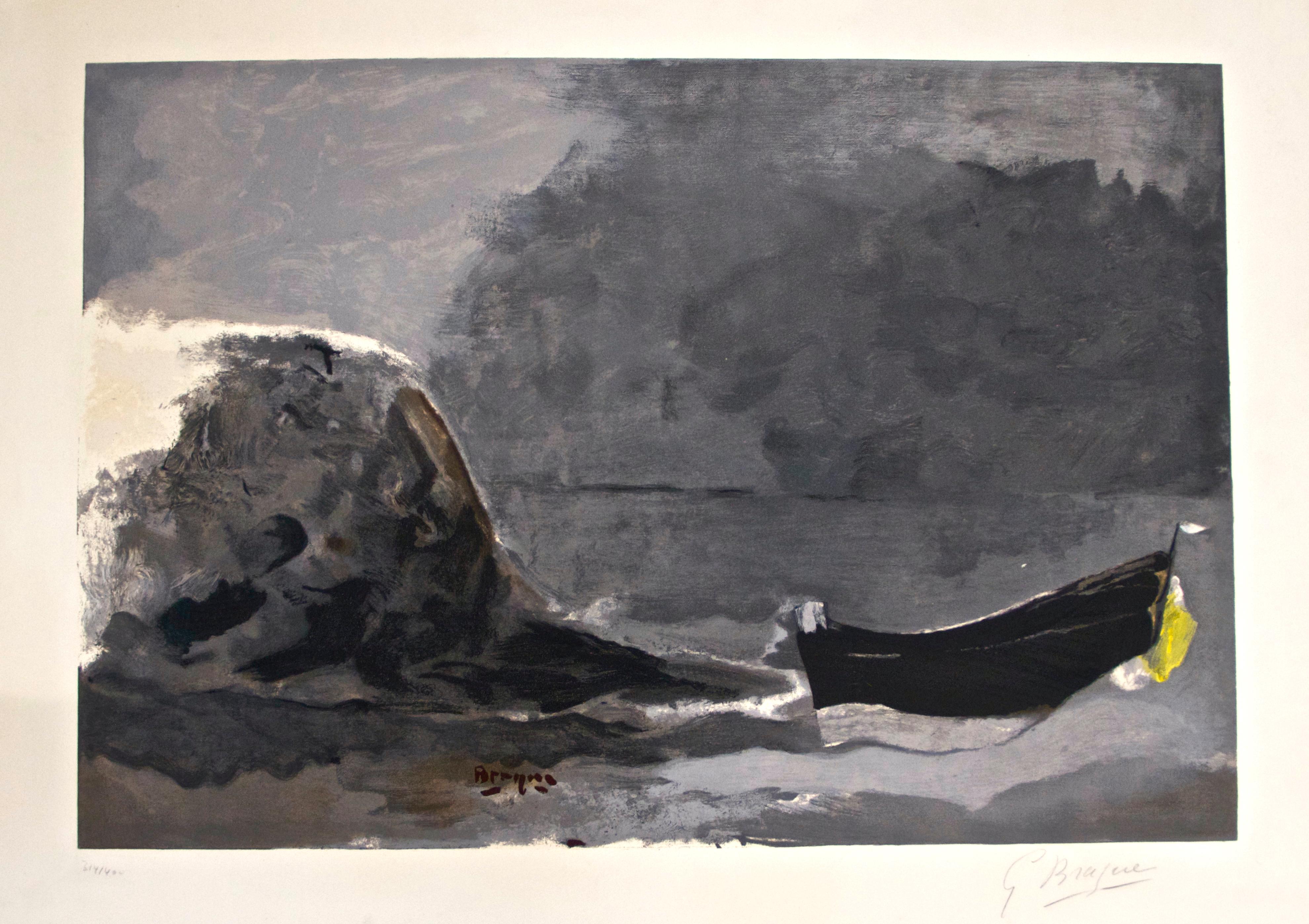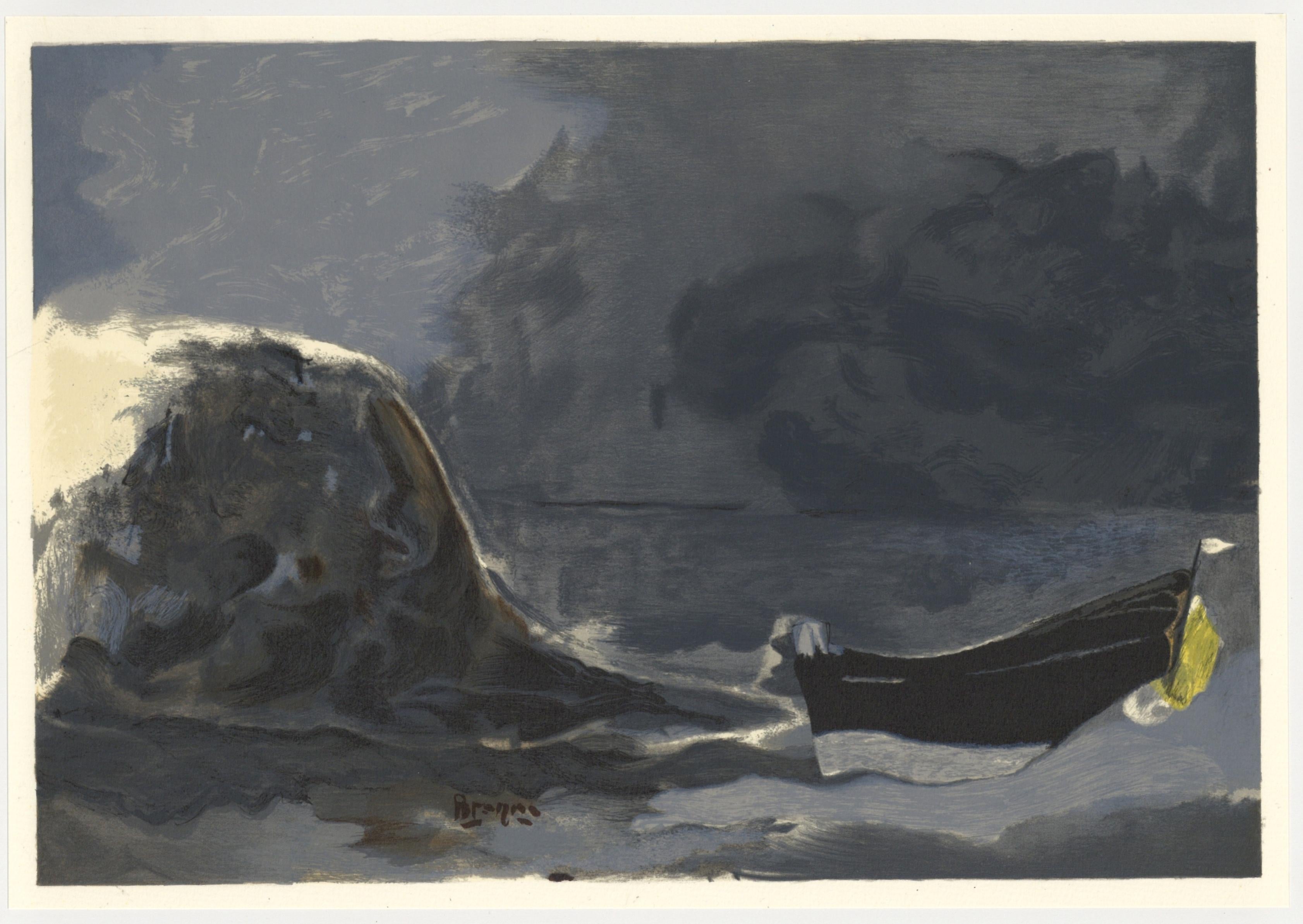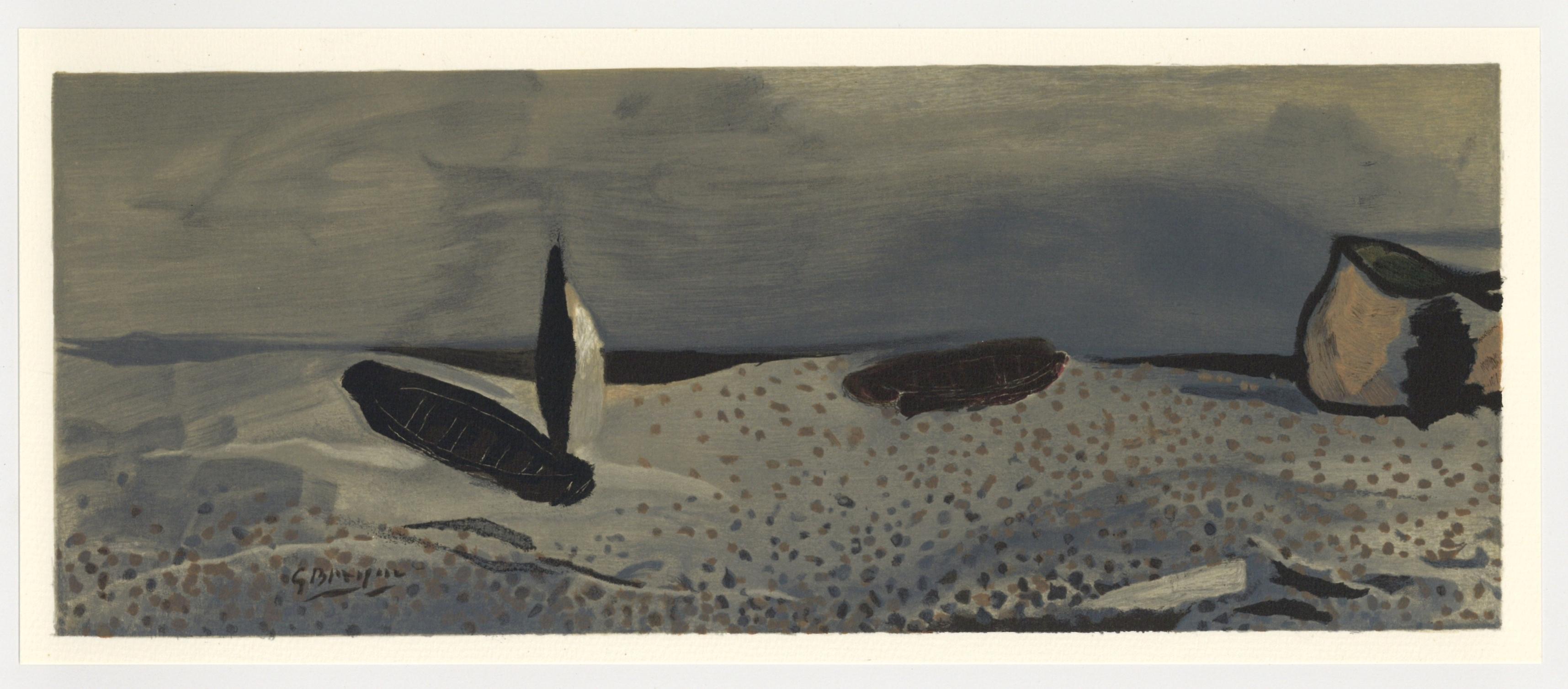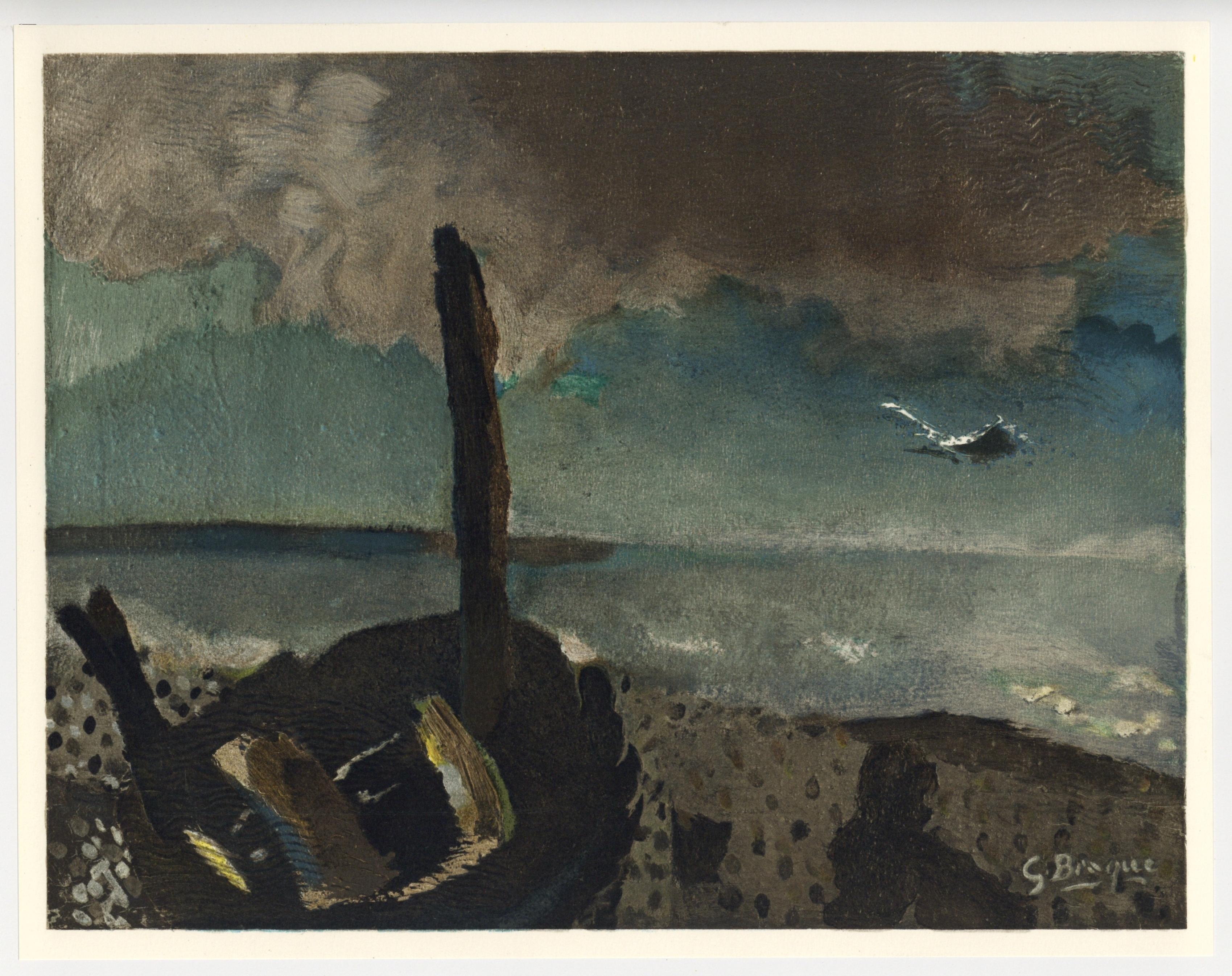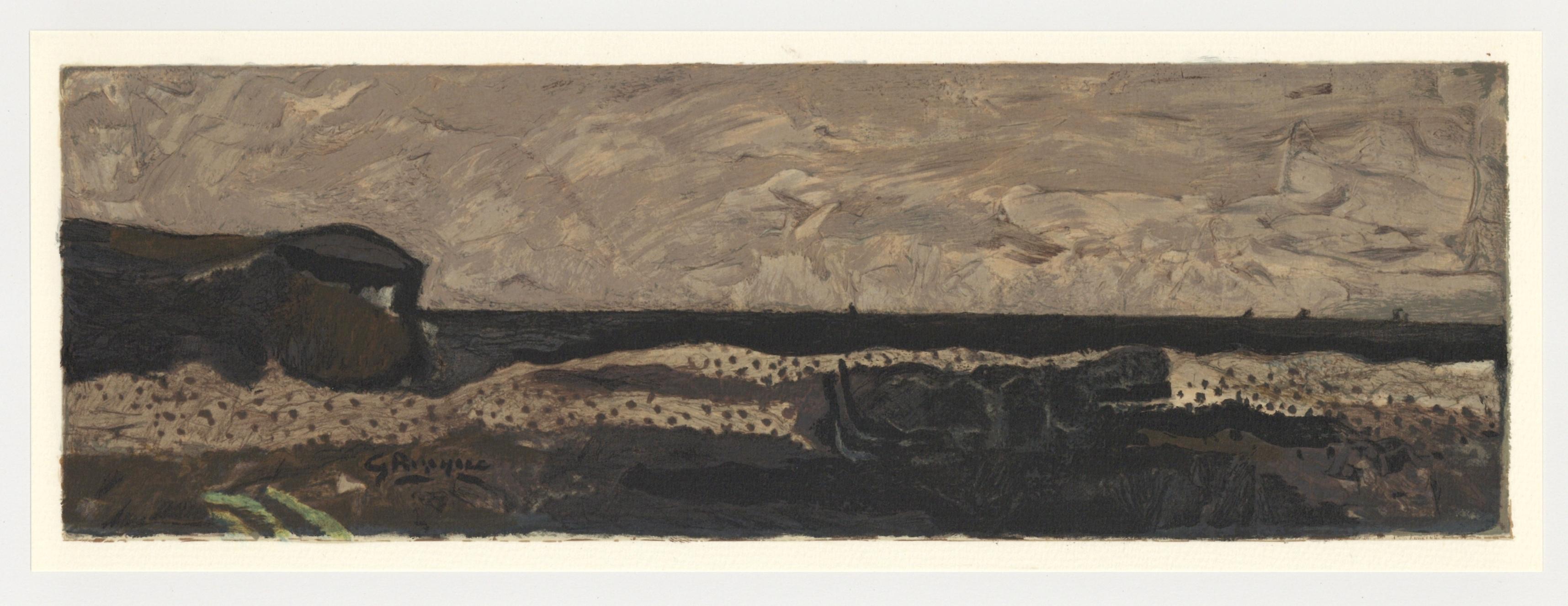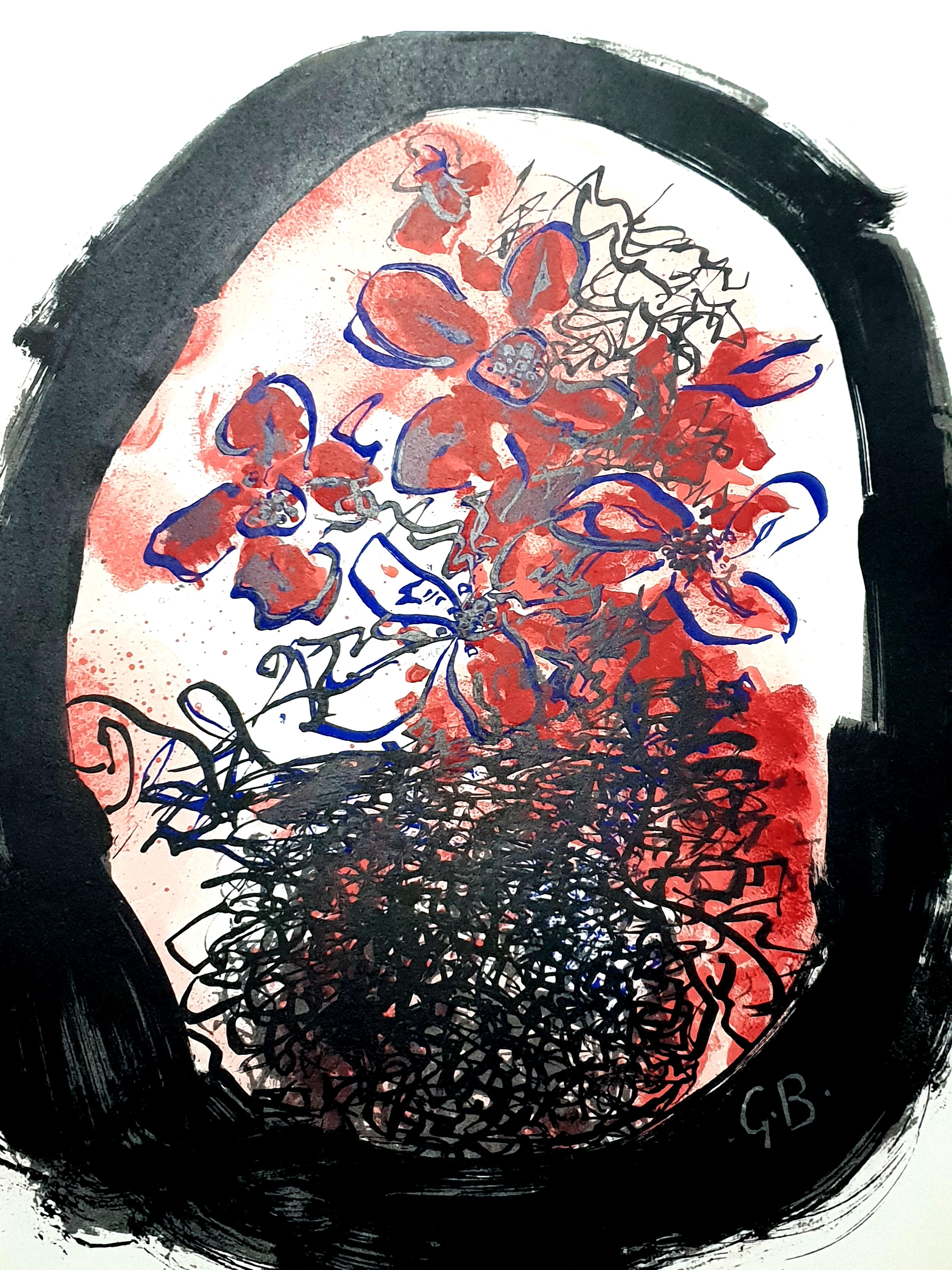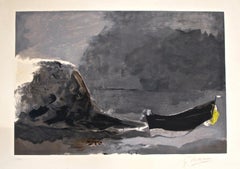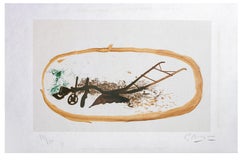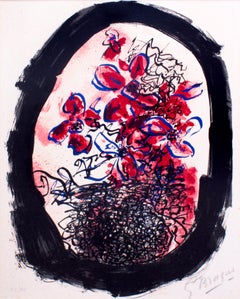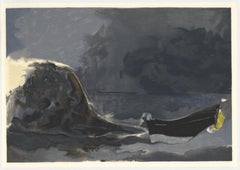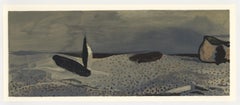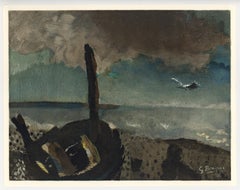Items Similar to Marine Noire - Lithograph After Georges Braque - 1956
Want more images or videos?
Request additional images or videos from the seller
1 of 7
After Georges BraqueMarine Noire - Lithograph After Georges Braque - 19561956
1956
$4,030.73
£3,018.89
€3,400
CA$5,657.77
A$6,188.96
CHF 3,224.53
MX$74,467.14
NOK 40,834.40
SEK 38,339.59
DKK 25,897.45
About the Item
"Marine Noire" is a lithograph after the work of Georges Braque in 1956. The print is hand signed and numbered. This is an edition of 400 prints.
Bibliography: D. Vallier, Braque. L'oeuvre gravé, Flammarion, Paris 1982, n. 1044, p. 296.
Good conditions except for very light foxings and little folds on the corner.
Georges Braque (1882-1963) was a French Fauve painter who began to rethink his own painting style after admiring Picasso’s Les Demoiselles. Using the painting’s revolutionary elements as a point of departure, together Braque and Picasso invented Cubism around 1908 in the belief the art of painting had to move far beyond the depiction of visual reality. Most scholars call the first phase of Cubism, developed cooperatively by Picasso and Braque, Analytic Cubism because essentially it is a painterly study of the structure of the form.
- Creator:After Georges Braque
- Creation Year:1956
- Dimensions:Height: 25.6 in (65 cm)Width: 35.44 in (90 cm)Depth: 0.04 in (1 mm)
- Medium:
- Movement & Style:
- Period:
- Condition:Insurance may be requested by customers as additional service, contact us for more information.
- Gallery Location:Roma, IT
- Reference Number:Seller: M-1094991stDibs: LU65036907752
About the Seller
4.9
Platinum Seller
Premium sellers with a 4.7+ rating and 24-hour response times
1stDibs seller since 2017
7,748 sales on 1stDibs
Typical response time: 2 hours
- ShippingRetrieving quote...Shipping from: Grasse, France
- Return Policy
Authenticity Guarantee
In the unlikely event there’s an issue with an item’s authenticity, contact us within 1 year for a full refund. DetailsMoney-Back Guarantee
If your item is not as described, is damaged in transit, or does not arrive, contact us within 7 days for a full refund. Details24-Hour Cancellation
You have a 24-hour grace period in which to reconsider your purchase, with no questions asked.Vetted Professional Sellers
Our world-class sellers must adhere to strict standards for service and quality, maintaining the integrity of our listings.Price-Match Guarantee
If you find that a seller listed the same item for a lower price elsewhere, we’ll match it.Trusted Global Delivery
Our best-in-class carrier network provides specialized shipping options worldwide, including custom delivery.More From This Seller
View AllMarine Noire - Lithograph after Georges Braque - 1956
Located in Roma, IT
Signed and numbered.
Editions of 400 prints.
published by Maeght, Paris
Literature Reference:
D. Vallier, Braque. L'oeuvre gravé, Flammarion, Paris 1982, n. 1044, p.296.
Image Dimensions :50 x 72...
Category
1950s Post-Impressionist Landscape Prints
Materials
Lithograph
La Charrue - Lithograph by Georges Braque - 1960
By Georges Braque
Located in Roma, IT
Hand signed and numbered. Edition of 150 prints.
Category
1960s Modern Figurative Prints
Materials
Lithograph
Le Repos - Original Lithograph After G. Braque - 1967
By (after) Georges Braque
Located in Roma, IT
Le Repos is an original lithograph realized by Georges Braque (After) (Argenteuil, 1882 - Paris, 1963) in 1967.
Original Lithograph on paper.
Published by Maeght Editeur, Paris. Credits printed on rear.
Mint Conditions.
Georges Braque (1882-1963) was a French Fauve painter who began to rethink his own painting style after admiring Picasso’s Les Demoiselles...
Category
1960s Fauvist Still-life Prints
Materials
Lithograph
Frontispiece from Braque Lithographe - Lithograph 1961
By Georges Braque
Located in Roma, IT
Hand signed and numbered.
Edition of 125 prints.
Ref.: Catalogue D.Vallier pag.284
Passepartout included : 69 x 49 cm
Very good conditions.
Georges Braque
(Argenteuil, 1882 – Paris...
Category
1960s Modern Figurative Prints
Materials
Lithograph
The Black Birds - Lithograph After Georges Braque - 1958
By (after) Georges Braque
Located in Roma, IT
The Black Birds is a lithograph published by Maeght after an original composition by Georges Braque in 1958. Braque authorized and selected certain works to be reproduced by his tru...
Category
1950s Contemporary Abstract Prints
Materials
Lithograph
$5,512 Sale Price
25% Off
Oiseau et Lotus - Lithograph by Georges Braque - 1963
By Georges Braque
Located in Roma, IT
Oiseau et Lotus is a color lithograph on paper, realized by the French Cubist artist, Georges Braque (1882-1963).
Printed by ARTE in 1963 by order of Galerie Maeght in Paris in a ci...
Category
1960s Modern Abstract Prints
Materials
Lithograph
You May Also Like
"Marine noire" lithograph
By (after) Georges Braque
Located in Henderson, NV
Medium: lithograph (after the painting). Printed in 1968 by L'Imprimerie Arte and published by the atelier Maeght for the Varengeville portfolio. Size: 9 5/8 x 13 3/4 inches (244 x 3...
Category
1960s Prints and Multiples
Materials
Lithograph
"Marine" lithograph
By (after) Georges Braque
Located in Henderson, NV
Medium: lithograph (after the painting). Printed in 1968 by L'Imprimerie Arte and published by the atelier Maeght for the Varengeville portfolio. Size: 5 3/4 x 13 3/4 inches (145 x 3...
Category
1960s Prints and Multiples
Materials
Lithograph
"Marine à la Mouette" lithograph
By (after) Georges Braque
Located in Henderson, NV
Medium: lithograph (after the painting). Printed in 1968 by L'Imprimerie Arte and published by the atelier Maeght for the Varengeville portfolio. Size: 10 3/4 x 13 3/4 inches (272 x ...
Category
1960s Prints and Multiples
Materials
Lithograph
"La plage de Varengeville" lithograph
By (after) Georges Braque
Located in Henderson, NV
Medium: lithograph (after the painting). Printed in 1968 by L'Imprimerie Arte and published by the atelier Maeght for the Varengeville portfolio. Size: 5 x 13 3/4 inches (125 x 350 m...
Category
1960s Prints and Multiples
Materials
Lithograph
Georges Braque - Original Lithograph
By Georges Braque
Located in Collonge Bellerive, Geneve, CH
Georges Braque - Original Lithograph
1963
Dimensions: 32 x 24 cm
Andre Sauret, Monte Carlo
The father of Cubism
Three Cubist that distinguishes art historian periods were initiated and developed by Georges Braque: The Cubist Cézanne (1907-1909), Executive (1909-1912) and synthetic (1912-1922).
Post-Impressionist and fawn, Braque no longer adheres to the contingency of a decorative way or the other. Cézanne’s paintings exhibited at the Grand Palais during the retrospective of 1907 are a revelation: Cézanne sought and invented a pictorial language. In his footsteps, Braque went to the South with the reasons of the Master. He returned with Estaque landscapes and surprising Ciotat it keeps Cezanne geometric model and retains the “passages” continuity from one surface to another to create the sensation of “turning around” of the object represented. But he wants to go after the consequences of the vision of Cezanne. In his paintings Houses in L’Estaque (1908) it simplifies the volumes of houses, neglects detail by removing doors and windows: the plastic rhythm that builds the table. Large Nude , a masterpiece of the period, can be considered the first work of Cézanne cubism .
Systematizing and deepening Braque discoveries open the door analytical cubism. In 1909, his painting became more cerebral than sensual. The pattern is recreated in the two-dimensionality of the canvas, leaving aside any illusionistic perspective. In Still Life with Violin, objects are analyzed facets according to their characteristic elements, each facet referring to a particular view of the object. There are so many facets of points selected view: Table reflects the knowledge of the object and the ubiquity of the eye. Moreover, Braque is looking for the essence of the objects in the world rather than their contingency, which explains the absence of light source and use of muted colors (gray, ocher), contingent aspects of the object . But formal logic has stepped facets, erased any anecdote to the object and ultimately led to his painting a hermetic more marked on the edge of abstraction (see the series of Castle Roche-Guyon ).
Braque, anxious to keep the concrete and refusing at all costs that the logic of Cubism takes the paintings to abstract, reintroduced signs of reality in his paintings in 1912 marks the beginning of Synthetic Cubism. Historians speak of “signs of real” rather than reality because what interests Braque, this is not to put reality into a table, but to create a painting which, by its language, refers to the real. To do this, he invented two major techniques XX th century inclusions and contributions. The inclusions consist of painting objects that have no real depth, materials (wallpaper in Nature morte aux playing cards faux wood is a pictorial inclusion) or letters (calligraphic inclusion in Portuguese ), made first brush and a few months later stencil. Contributions are defined in contrast with the collage on canvas of foreign materials: glued or sand paper, sawdust, etc.. Regarding the collages, Braque used for the first time in September 1912 a piece of adhesive paper imitating faux wood Compote and Glass , then the packet envelope of tobacco Bock in 1912-1913, or an advertisement in Damier , 1913). Inputs and inclusions refer to an external object in the table, without “emulate” this object. Away from their appearances, objects are represented in closest essence of the objects in the real world sense.
This is also the time of Synthetic Cubism that Braque invented paper sculpture. There are, unfortunately, and no one is living proof of a photograph makes it possible to realize: Paper and paperboard.
Métamorphoses period(1961-1963).
In 1961, Georges Braque worked on a Greek head for the Louvre, which obsesses him, and he wishes to free his mind. He tried several times to bring out the paint and the result was unsatisfactory. He thinks the ultimate metamorphosis its Greek head projected in three dimensions. He calls in his studio of Baron Heger Loewenfeld, master lapidary, and he communicates his enthusiasm during the “fateful encounter.” Nine months later, in honor of the eighty years of Georges Braque, Heger Loewenfeld offers the Master of the ring Circe: the famous Greek head finally exorcised, carved in an onyx. Braque Loewenfeld then asked to identify other issues that haunt him.
From dated and signed by Georges Braque, Heger gouaches Loewenfeld shapes works in the fields of jewelery, lapidary art...
Category
1960s Modern Figurative Prints
Materials
Lithograph
"Barque sur les galets" lithograph
By (after) Georges Braque
Located in Henderson, NV
Medium: lithograph (after the painting). Printed in 1968 by L'Imprimerie Arte and published by the atelier Maeght for the Varengeville portfolio. Size: 8 1/4 x 13 3/4 inches (210 x 3...
Category
1960s Prints and Multiples
Materials
Lithograph
More Ways To Browse
Vintage Baby Portraits
Vintage Boxing Painting
Vintage Womens Pins
18th Century Dog Paintings
Acrylic Flower Sculpture
Bay Area California Artist
Celotto Afro
Charles Church
Charpentier Georges
Cycladic Art
Emperor Penguin
English Country House Painting
Expressionist Clay Sculpture
French Military Paintings
Frilli Gallery
Glass Cube Sculpture
Grinling And Gibbons
Helen Of Troy
